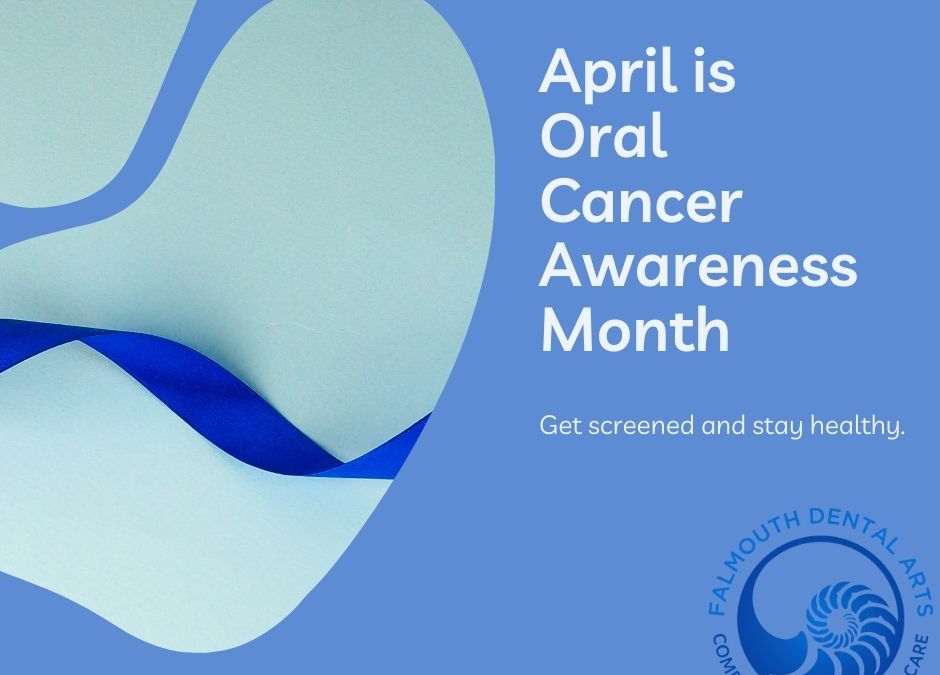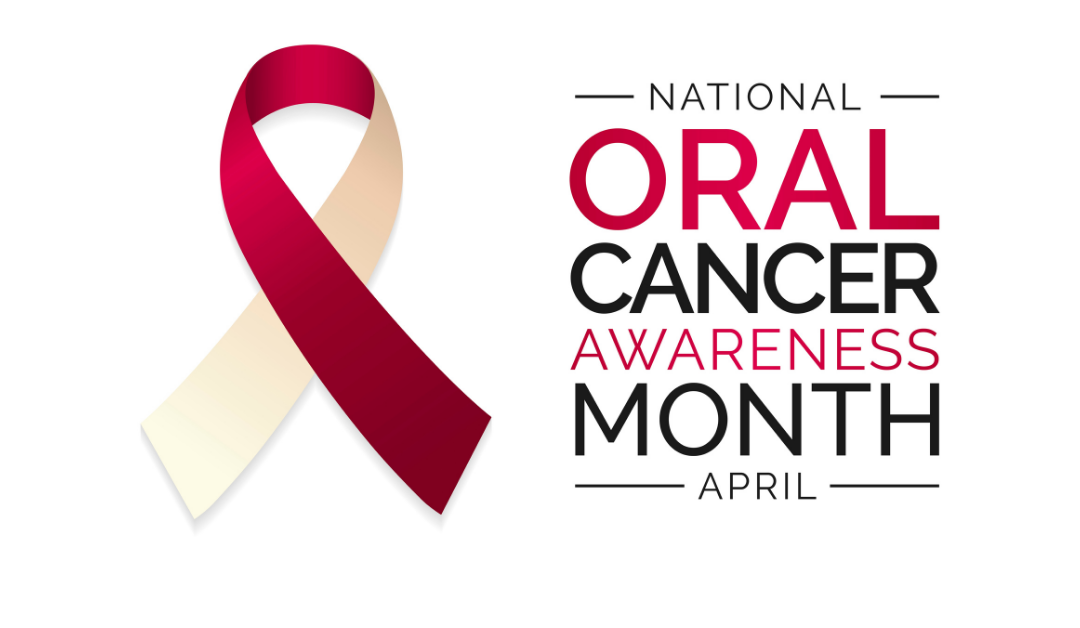
Apr 2, 2024
Did you know that regular dental care is a first line of defense for oral cancer? April is Oral Cancer Awareness month and is an opportunity to talk about the importance of early detection. It’s encouraging to note that when oral cancer is detected and treated early, there is a 80-90% survival rate. At Falmouth Dental Arts, we’ve long had a commitment to oral cancer screenings for our patients. Dr. Brunacini and Dr. Karagiorgos as well as our hygienists perform screenings during your regular check up appointments. To help raise awareness and answer questions, we wanted to provide some basic information about our screening procedures and common oral cancer warning signs.
Why Oral Cancer Awareness is Important
According to the Oral Cancer Foundation, about 58,500 people are diagnosed with oral cancer each year in America, which translates to 132 people each day. While smoking is the leading cause of oral cancer, there are increasingly more and more young people developing oral cancer due to the HPV virus.
FDA’s Oral Cancer Screening
At FDA, Dr. Brunacini, Dr. Karagiorgos, and our hygienists perform oral cancer screenings for our patients at every hygiene appointment. These screenings may include:
We start with a visual exam of the mouth, looking at the gum tissue, lips, checks, and tongue. Additionally we gently palpate or press on areas of the face and neck to check for any irregular lumps. If we have any concerns, we may offer to do a screening with VELscope. VELscope is a screening device that emits a blue light that quickly identifies abnormal cells before they are visible to the naked eye. It is a safe and non-invasive procedure and helpful for early detection of oral cancer.
FDA also performs CBCT 3D X-Rays which enables us to better visualize all of the structures within the head, neck, and mouth and assess our patients’ oral health. 3D imaging can be helpful in determining subsequent steps for the ideal treatment of an area of concern.
If we have any reason for concern after performing a screening, our next step would be to refer you to an oral surgeon for additional consultation and a possible biopsy. As your partner in oral health, we will remain involved every step of the way to provide support and follow-up care.
Oral Cancer Warning Signs
You also have an opportunity to screen for oral cancer in your home care. For example, if you notice any changes to your mouth or experience any pain or tenderness, you should let us know. Also, you can be on the lookout for some of the common warning signs for oral cancer, including:
- White or red patches in the mouth
- Sores that fail to heal
- Abnormal lumps in the gums or neck
- Difficulty chewing or swallowing
If you do discover an area of concern, please let us know so we can see you promptly for a thorough exam. As always, when you have any questions about your oral health or the oral cancer screening process, please don’t hesitate to call us! As your dentist, we are part of your healthcare team and happy to answer your questions!

Apr 2, 2023
April is Oral Cancer Awareness month and regular dental care is a first line of defense against oral cancer. Falmouth Dental Arts is committed to helping raise awareness about the importance of oral cancer screenings. According to the Oral Cancer Foundation, about 54,000 people are diagnosed with oral cancer each year in America. Smoking is the leading cause of oral cancer, but there are increasingly more and more young people developing oral cancer due to the HPV virus. The good news is that when treated early, oral cancer has a 80-90% survival rate and regular screenings assist with early detection. At FDA, Dr. Brunacini and Dr. Karagiorgos as well as our hygienists perform oral cancer screenings during your regular check-up appointments. With the goal of raising awareness, we thought it would be helpful to discuss some of the common warning signs related to oral cancer and the different types of screenings available at FDA.
Warning Signs of Oral Cancer
A good rule of thumb is to let us know if you notice any recent changes to your mouth, teeth or gums, or experience any pain or tenderness. Beyond that, there are a few warning signs linked with oral cancer to be aware of:
- White or red patches in the mouth
- Sores that fail to heal
- Abnormal lumps in the gums or neck
- Difficulty chewing or swallowing
If you discover something on your own, don’t panic. As your dental care partners, we are an essential part of your healthcare team! You can schedule an appointment with us for a prompt examination. You may wonder how Dr. Brunacini, Dr. Karagiorgos and our hygienists perform oral cancer screenings. Here is some more information on the different types of screening we perform at FDA:
Visual Oral Cancer Screening
We screen our patients for oral cancer at every hygiene appointment. Our screening methods typically include a simple visual exam of the soft tissues of the mouth. We will examine the gum tissue, lips, cheeks, and tongue. We will also palpate (gently press on) areas of the face and neck to check for any nodules or lumps. If there is an area of concern, we may offer to do a VELscope screening.
VELscope Screening
VELscope is a safe, non-invasive early detection screening device that emits a blue light that quickly allows our clinicians to identify abnormal cells before they are visible to the naked eye. The graphic below demonstrates the difference between healthy cells (Normal Epithelial Cells) and abnormal cells (Abnormal or Dysplastic Epithelial Cells), that become visible under the Blue Excitation Light.
CBCT 3D X-Ray
3D x-ray or CBCT (cone beam computed tomography) technology allows us to better visualize all of the structures within the head, neck, and mouth so that we can better assess our patients’ oral health. 3D imaging can be helpful in determining subsequent steps for the ideal treatment of a lesion.
If we have any reason for concern, the next step would be a referral to an oral surgeon for additional consultation. An oral surgeon may decide to perform a biopsy of the area for further evaluation. Most of the time, a biopsy will rule out oral cancer. However, if the biopsy is positive for precancerous or cancerous cells, additional treatment may be necessary. Throughout the evaluation and referral process, we will remain involved every step of the way to provide support and follow-up care.
If you have any questions or concerns about your oral health or the oral cancer screening process, please don’t hesitate to call us! As your dentist, we are part of your healthcare team and always happy to answer your questions!

Apr 14, 2022
April is Oral Cancer Awareness Month, an opportunity for dental practices like Falmouth Dental Arts to raise awareness about the importance of oral cancer detection and prevention. When treated early, oral cancer has an estimated 80-90% survival rate. As your dental care partners, we believe strongly that we are an essential part of your healthcare team. As such, we’ve had a long-standing commitment to screening our patients for early signs of oral cancer. We are excited to announce that we now have a new state-of-the-art diagnostic tool to assist us in the oral cancer screening process – a CBCT 3D x-ray machine. 3D imaging allows us to better diagnose a range of dental issues, including oral cancer. Learn more from Dr. Brunacini, as he explains some of the advantages of CBCT 3D x-rays.
1) Why has FDA upgraded to 3D x-rays?
Dr. Brunacini: 3D x-ray or CBCT (cone beam computed tomography) technology allows us to better visualize all of the structures within the head, neck, and mouth so that we can better assess our patients’ oral health.
2) How are 3-D x-rays different from the traditional digital 2D x-rays?
Dr. Brunacini: For years, dentistry has been taking and reviewing x-rays in 2-D, which can sometimes make it difficult to determine a proper diagnosis. Without the 3rd dimension, it can be difficult to see an area of concern, such as a gum or tooth infection. Being able to take 3D images allows us to more thoroughly and completely diagnose our patients prior to performing any dental treatment, especially oral surgery.
3) Will 3D x-rays replace traditional 2D x-rays?
Dr. Brunacini: 3D imaging won’t replace our typical bitewing x-rays, which are used to locate areas of decay. Rather, 3D x-rays can be used as an additional tool when trying to diagnose an area of concern or when planning for dental implants. It can also be helpful for patients with a strong gag response, as 3D x-rays allow us to get the imaging we need without placing anything into their mouth, making the process much easier and more comfortable for them.
4) How can 3D x-rays be helpful in the early detection of oral cancer?
Dr. Brunacini: CBCT technology can be used as an additional screening tool in diagnosing oral cancer. It doesn’t eliminate the need for our other screening methods, such as a visual or physical exam or VELscope screening. VELscope is a non-invasive device that emits a safe blue light to detect abnormal cell growth that could be cancerous or precancerous. If we identify any areas that look suspicious through these methods, 3D imaging can be helpful in determining subsequent steps for the ideal treatment of a lesion. As we see many of our patients twice a year, we now have a wider range of diagnostic tools available to us to screen for oral cancer during routine hygiene appointments, including CBCT x-rays.
Thank you, Dr. Brunacini!
If you have any additional questions about the oral cancer screening process, CBCT 3D x-rays, or would like to schedule an appointment, give us a call at 207.781.5900. We’re here to help!
Apr 28, 2014
 In observation of Oral Cancer Awareness Month, we wanted to provide you with some information about the human papillomavirus (HPV) and oral cancer and the links between the two.
In observation of Oral Cancer Awareness Month, we wanted to provide you with some information about the human papillomavirus (HPV) and oral cancer and the links between the two.
There are more than 40 types of HPV that can affect the mouth and throat areas, most of which congregate near the base of the tongue and tonsil area, known as the “oropharynx.” HPV is the most common sexually transmitted infection (STI) in the United States, but only HPV type 16 has been found in oropharyngeal cancer.
The human body typically fights off the HPV infection naturally, but the infection has the potential to turn regular cells in infected skin into irregular cells—sometimes irreversibly so. According to the U.S. Center for Disease Control, “about 7% of people have oral HPV,” and of that number, “only 1% of people have the type of oral HPV that is found in oropharyngeal cancers.”




